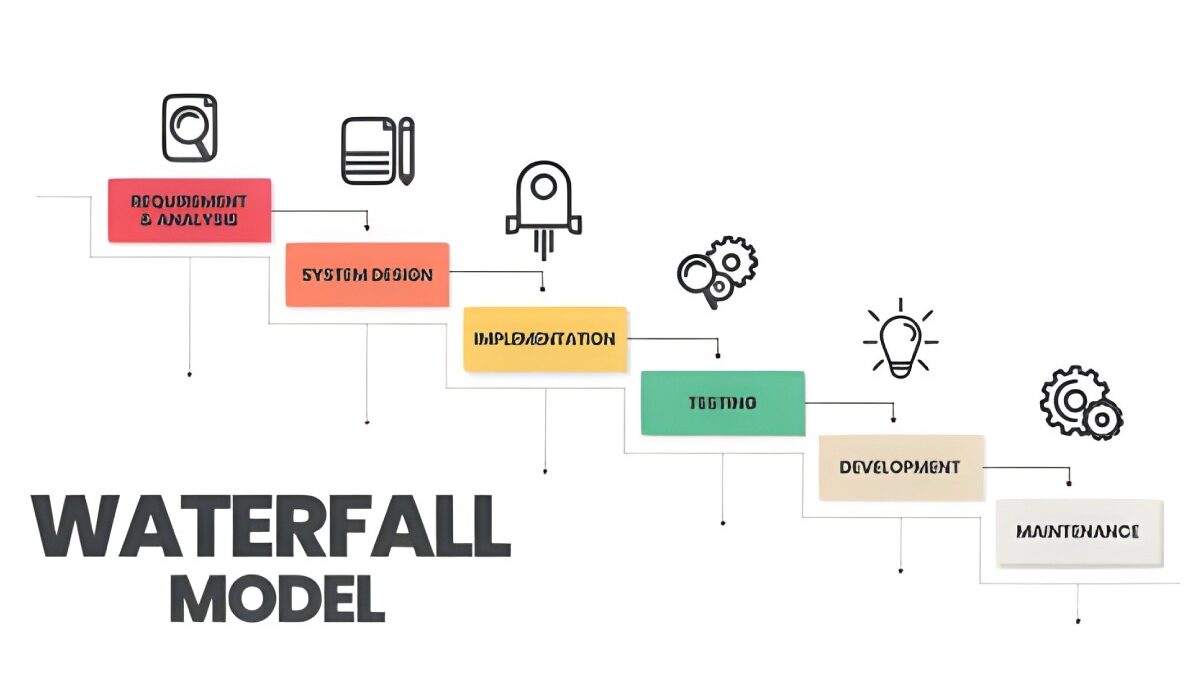Introduction: Why Many Projects Still Struggle Without Structure
Have you ever worked on a project that fell apart because no one followed a plan?
In the fast-moving tech world, teams often jump straight into coding without clear goals — and that’s where problems begin. Deadlines slip, bugs pile up, and everyone blames “poor communication.”
That’s exactly why the tech waterfall model was created — to bring structure, order, and accountability to complex projects.
Even though it’s an older method, it still offers valuable lessons and real benefits for certain types of software development today.
Table of Contents
What Is the Tech Waterfall Model?
The tech waterfall model is a step-by-step approach to building software.
Each phase flows into the next, just like a waterfall — once you complete one stage, you move forward without going back.
Here’s how it works:
- Requirements: Define what the software must do.
- Design: Plan how it will look and function.
- Development: Write and integrate the code.
- Testing: Find and fix bugs.
- Deployment: Release for users.
- Maintenance: Keep it running smoothly.
This clear sequence helps teams stay organized and document every stage — making it ideal for large or regulated projects.
Why the Waterfall Model Became a Tech Standard
The waterfall model rose to fame because it made complex projects manageable.
According to IBM, this approach helped engineers keep software predictable, documented, and traceable — all key needs in early computing.
It became especially useful for:
- Projects with strict goals and fixed requirements
- Teams needing formal documentation
- Government or aerospace programs where safety and compliance were critical
NASA, for instance, used a waterfall-like approach during the Apollo missions, where each step had to be reviewed and verified before moving on.
The Problem: Why Waterfall Doesn’t Fit Every Project
In today’s fast-paced tech world, the waterfall model has limits.
- 💡 Hard to change: Once coding starts, it’s tough to adjust requirements.
- 🕐 Slower delivery: You can’t test or adapt mid-project.
- 💰 Expensive to fix mistakes: Problems found late cost more to correct.
Atlassian points out that modern software projects often need flexibility and user feedback — things the waterfall model doesn’t handle well.
The Solution: A Smarter, Hybrid Approach
Many teams today use hybrid models, blending the discipline of waterfall with the flexibility of Agile.
This approach keeps the planning and documentation of waterfall but adds short feedback loops from Agile.
It helps developers move faster, avoid waste, and still maintain structure — ideal for projects that can’t afford chaos but need some adaptability.
Waterfall vs. Agile — At a Glance
| Feature | Tech Waterfall | Agile Method |
| Structure | Step-by-step | Iterative cycles |
| Flexibility | Fixed | Adjustable |
| Feedback | At project end | Throughout process |
| Best for | Predictable, stable projects | Evolving, fast-paced projects |
Key Takeaways
- The tech waterfall model brings structure and clarity to complex projects.
- It’s best for stable, safety-critical, or heavily regulated work.
- Today, teams often combine waterfall and Agile for balance between control and speed.
FAQs
Q1: Why is it called the waterfall model?
Because each stage flows into the next in a one-way direction — like water cascading down steps.
Q2: Is the waterfall model still used today?
Yes, especially in aerospace, healthcare, and government systems where requirements rarely change.
Q3: What’s the biggest weakness of the waterfall model?
It’s not flexible — any mid-project change can delay delivery or raise costs.
Q4: Can you mix waterfall with Agile?
Absolutely. Many teams now use a hybrid approach for better adaptability and documentation.
Disclosure:
This article was prepared using verified web and peer-reviewed sources, including IBM, NASA, and IEEE publications. AI assistance was used to collect information, organize it clearly, and ensure factual accuracy.
Disclaimer:
This content is for general educational purposes and should not replace professional or academic advice.
Key References
- IBM. (2023). Waterfall model overview. Retrieved from https://www.ibm.com
- NASA. (2020). Systems Engineering Handbook (Rev 2). NASA SP-2016-6105.
- Atlassian. (2024). Waterfall vs Agile: Which is better? Retrieved from https://www.atlassian.com/agile/project-management/waterfall-model
- Royce, W. W. (1970). Managing the Development of Large Software Systems. IEEE WESCON Proceedings.
- IEEE Computer Society. (2023). Software Engineering Standards Collection.

